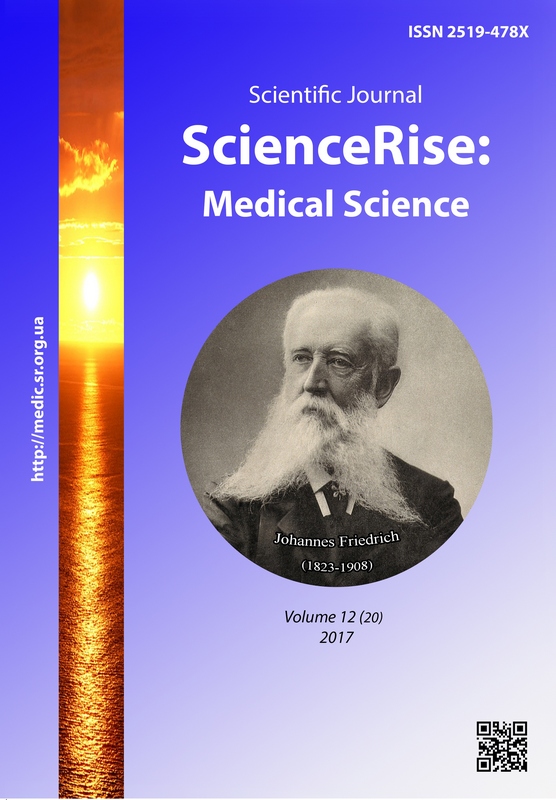Content of α-, -interferon and neopterin in blood serum of women with parvovirus infection in different periods of pregnancy
DOI:
https://doi.org/10.15587/2519-4798.2017.119936Keywords:
pregnancy, parvovirus infection, alpha- and gamma-interferon, neopterinAbstract
The aim of the study was to determine α-, g-interferon (IFN) and neopterin levels in blood serum of pregnant women with a parvovirus infection.
Methods and materials: There were examined 129 pregnant women, infected with a parvovirus В19, and 16 women with physiological pregnancy in I, II and III trimesters. Each group of pregnant women (I, II, III) was divided in two subgroups, depending on the presence or absence of clinical complications. The quantitative evaluation of α-, g-IFN and neopterin content in blood serum was realized by the method of immune-enzyme analysis.
Results of research: Blood serum of infected pregnant women contained increased α-and g-IFN levels, most expressed at studying IFN-γ levels that reliably exceeded control indices in I-III groups in 3,4-2,9-2,1 times respectively. At the presence of clinical complications in different periods of pregnancy women demonstrated the reliably decreased α-IFN level and reliably increased g-IFN level compared with pregnant women without clinical complications. High levels of neopterin were revealed in blood serum of infected women that testifies to the activation of a monocytic link of the cellular immunity at the impact of g-IFN. At comparing the subgroups of pregnant women it was established, that changes of the neopterin level in blood serum relative to control values had the unidirectional character, but women with clinical complications of pregnancy demonstrated the more essential exceed of control values in different trimesters– in 2,9; 2,9 and 3,1 times.
Conclusions. The increase of IFN-g and neopterin up to high values reflects the activation of a cellular immunity link and can play an important role in the pathogenesis of pregnancy complicationsReferences
- Noyola, D. E. (2004). Parvovirus B19 infection in medical students during a hospital outbreak. Journal of Medical Microbiology, 53 (2), 141–146. doi: 10.1099/jmm.0.05417-0
- Feldman, D. M., Timms, D., Borgida, A. F. (2010). Toxoplasmosis, Parvovirus, and Cytomegalovirus in Pregnancy. Clinics in Laboratory Medicine, 30 (3), 709–720. doi: 10.1016/j.cll.2010.04.009
- Tolfvenstam, T., Broliden, K. (2009). Parvovirus B19 infection. Seminars in Fetal and Neonatal Medicine, 14 (4), 218–221. doi: 10.1016/j.siny.2009.01.007
- Litvitskiy, P. F., Sinelnikova, T. G. (2009). Innate immunity – implementation mechanisms and pathological syndromes. Voprosy Sovremennoi Pediatrii, 8, 95–101.
- Korostelev, A. A., Gaifulin, P. Sh. (2013). Interferon status in chronic recurrent herpes-infection. Russian jornal of immunology, 7 (16) (2-3), 138–150.
- Hmelevsky, V. I., Provotorov, V. J., Kiseleva, V. V., Devyanin, O. A. (2014). Alpha-interferon in clinical practice. Archive internal medicine, 5 (19), 34–38.
- Lohoff, M., Mak, T. W. (2005). Roles of interferon-regulatory factors in T-helper-cell differentiation. Nature Reviews Immunology, 5 (2), 125–135. doi: 10.1038/nri1552
- Van Reeth, K. (2000). Cytokines in the pathogenesis of influenza. Veterinary Microbiology, 74 (1-2), 109–116. doi: 10.1016/s0378-1135(00)00171-1
- Shevchenko, O. P., Olefirenko, G. A., Orlova, O. V. (2000). Ispolsovaniye neopterina dlya ozenki aktivacii kletochnogo immuniteta [Use of neopterin to evaluate the activation of cellular immunity]. Laboratoriya, 4, 6.
- Murr, C., Widner, B., Wirleitner, B., Fuchs, D. (2002). Neopterin as a Marker for Immune System Activation. Current Drug Metabolism, 3 (2), 175–187. doi: 10.2174/1389200024605082
- Sviridov, E. A., Telegina, T. A. (2005). Neopterin and its recovered forms – biological role and participation in cellular immunity. Biological chemistry reviews, 45, 355–390.
- Kutateteladze, M. M., Dudina, K. R., Znoyko, O. O et. al. (2016). Dynamics of neopterin levels in blood and urine of patients with ARVI of various etiology. Lechashchiy vrach, 2, 84–87.
- Rebrova, O. J. (2002) Statistical analysis of medical data: application package of applied programs STATISTIСA. Moscow: Media-Sphera, 312.
- Zhang, J. H., He, H., Borzychowski, A. M., Takeda, K., Akira, S., Croy, B. A. (2003). Analysis of Cytokine Regulators Inducing Interferon Production by Mouse Uterine Natural Killer Cells1. Biology of Reproduction, 69 (2), 404–411. doi: 10.1095/biolreprod.103.015529
- Zdravkovic, M., Knudsen, H. J., Liu, X., Hager, H., Zachar, V., Aboagye-Mathiesen, G., Ebbesen, P. (1997). High interferon alpha levels in placenta, maternal, and cord blood suggest a protective effect against intrauterine herpes simplex virus infection. Journal of Medical Virology, 51 (3), 210–213. doi: 10.1002/(sici)1096-9071(199703)51:3<210::aid-jmv11>3.0.co;2-o
- Habip, Z., Sohrabi, P., Saribas, S., Caliskan, R., Demirci, M., Karakullukcu, A. et. al. (2017). Neopterin and soluble CD14 levels as indicators of immune activation in cases with low anti-HCV reactivity and true HCV infection. Acta Virologica, 61 (03), 264–272. doi: 10.4149/av_2017_304
- Bratslavska, O., Platace, D., Miklaševičs, E., Fuchs, D., Martinsons, A. (2006). Influence of neopterin and 7,8-dihydroneopterin on the replication of Coxsackie type B5 and influenza A viruses. Medical Microbiology and Immunology, 196 (1), 23–29. doi: 10.1007/s00430-006-0025-y
Downloads
Published
How to Cite
Issue
Section
License
Copyright (c) 2017 Natalia Bondarenko

This work is licensed under a Creative Commons Attribution 4.0 International License.
Our journal abides by the Creative Commons CC BY copyright rights and permissions for open access journals.
Authors, who are published in this journal, agree to the following conditions:
1. The authors reserve the right to authorship of the work and pass the first publication right of this work to the journal under the terms of a Creative Commons CC BY, which allows others to freely distribute the published research with the obligatory reference to the authors of the original work and the first publication of the work in this journal.
2. The authors have the right to conclude separate supplement agreements that relate to non-exclusive work distribution in the form in which it has been published by the journal (for example, to upload the work to the online storage of the journal or publish it as part of a monograph), provided that the reference to the first publication of the work in this journal is included.









